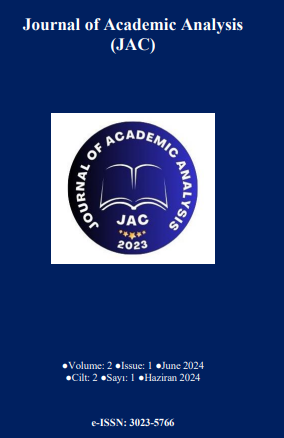Macroeconomic Dynamics Affecting Economic Growth in Fragile Five Countries: A Cointegration Approach
Keywords:
Fragile Five Countries, Cointegration Analysis, GrowthAbstract
Technological advancements have brought innovations across various fields, thereby facilitating commercial and financial activities between countries and significantly enhancing the fluidity of capital movements. While some countries have quickly adapted to these innovations, developing countries with limited capital mobility and restricted foreign capital reserves have experienced adverse economic impacts. In economic outlook reports published by Morgan Stanley in 2013 and Standard and Poor’s in 2017, the countries most affected by global financial movements were described as fragile. The main problems of countries with fragile economies were identified as increased borrowing costs due to high interest rates, excessive dependence on short-term foreign investments, instability in macroeconomic indicators, and fluctuations in exchange rates. This study aims to examine the relationship between growth and selected fundamental macroeconomic indicators in developing countries referred to as the Fragile Five between 1991 and 2021 using cointegration analysis. The findings from the analysis indicate that no cointegration relationship exists. Despite sharing similar characteristics, the absence of a long-term relationship was determined due to the differing growth dynamics of these countries.
References
Akel, V. (2015). Kırılgan beşli ülkelerinin hisse senedi piyasaları arasındaki eşbütünleşme analizi. Uluslararası Yönetim İktisat ve İşletme Dergisi, 11(24), 75-96.
Amaro, S. (2021). These are now the 5 most fragile countries exposed to higher interest rates, according to S&P " (Çevrimiçi). https://www.cnbc.com/2017/11/06/these-are-now-the-5-most-fragile-countries-exposed-to-higher-interest-rates-according-to-sp.html (Erişim Tarihi: 10.03.2024).
Aydın, Y. (2019). Finansal gelişme ve ekonomik büyüme ilişkisinin kırılgan beşli ülkeleri için analizi. Ekonomi Politika ve Finans Araştırmaları Dergisi, 4(1), 37-49.
Bayraktar, Y., Eğri, T. & Yildiz, F. (2016). A causal relationship between oil prices current account deficit, and economic growth: an empirical analysis from fragile five countries. Ecoforum Journal, 5(3), 29-44.
Çiğdem, G., & Altaylar, M. (2020). Cointegration evidences from the new fragile five. Journal Of Life Economics, 7(3), 269-282.
Dinçsoy, M. O., & Çan, H. (2019). Kırılganlık göstergeleri ve kırılgan beşli ülkeleri üzerine bir inceleme. The Journal of Academic Social Science, 22(22), 199-217.
Guillaumont, P., & Guillaumont Jeanneney, S. (2009). State fragility and economic vulnerability: what is measured and why? (No. P07). FERDI Working Paper.
Hacıgökmen, F. (2019). Ekonomik kırılganlıklar; G-20 ülkeleri üzerinde bir inceleme. Politik Ekonomik Kuram, 3(2), 192-213.
Hayaloğlu, P. (2015). Kırılgan beşli ülkelerinde finansal gelişme ve ekonomik büyüme ilişkisi: Dinamik panel veri Analizi. Ekonomik ve Sosyal Araştırmalar Dergisi, 11(1), 131-144.
Tezer, H. (2016). Türkiye Ekonomisinin 2003-2014 Yılları Arasındaki Makrekonomik Görünümü ve Ekonomik Kırılganlık Belirtileri. The Journal of Academic Social Science, 4(35), 144-165.
Kuepper, J. (2022) What Are the Fragile Five? Definition & Examples of the Fragile Five. (Çevrimiçi) https://www.thebalancemoney.com/what-are-the-fragile-five-1978880#citation-4 (Erişim Tarihi: 10.03.2024).
Lord, J. (2013). EM currencies: The fragile five (global outluk) (15–19). Morgan Stanley Research. Retrieved from http://graphics8.nytimes.com/packages/pdf/business/MorganStanleyFragileFive.pdf (Erişim Tarihi: 10.02.2024).
Mete, M., Pekmez, G., & Kıyançiçek, C. (2016). 2008 finans krizinin kırılgan sekizliler üzerindeki etkisi: Teorik bir inceleme. Elektronik Sosyal Bilimler Dergisi, 15(57).
Pesaran, M. H., Ullah, A., & Yamagata, T. (2008). A bias-adjusted LM test of error cross-section independence. Econometrics Journal, 11, 105-127.
Şimşek, N., Hazar, A., & Babuşçu, Ş. (2019). Türkiye’nin finansal kırılganlığına etki eden makro ekonomik faktörler. Ekonomi ve Finansal Araştırmalar Dergisi, 1(1-2), 48-74.
World Bank (2022). https://data.worldbank.org/indicator/BN.CAB.XOKA.CD (Çevrimiçi). (Erişim Tarihi: 10.12.2022).
Yerdelen Tatoğlu, F. (2012). İleri panel veri analizi. Beta Yayınları, İstanbul, 1. Basım.
Yerdelen Tatoğlu, F. (2020). Panel zaman serileri analizi. Beta Yayınları, İstanbul, 1. Basım.
Downloads
Published
How to Cite
Issue
Section
License
Copyright (c) 2024 Journal of Academic Analysis

This work is licensed under a Creative Commons Attribution 4.0 International License.



